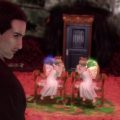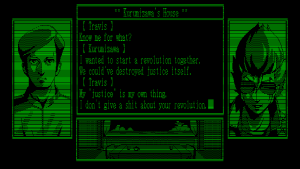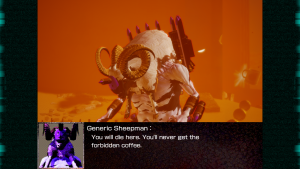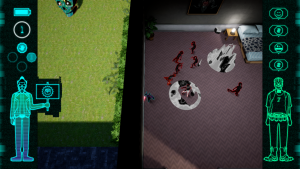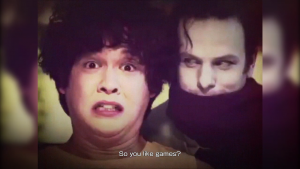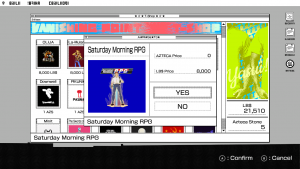- No More Heroes
- No More Heroes 2: Desperate Struggle
- Travis Strikes Again: No More Heroes
- No More Heroes III
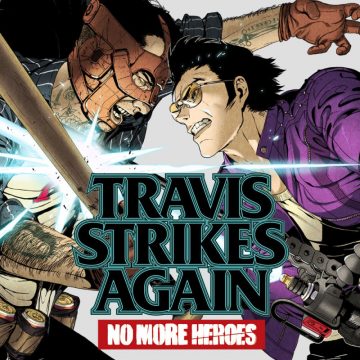
Travis Strikes Again is a modest game, but also an important one for Goichi Suda. The now infamous SUDA 51 hit a long low point in his career as he stepped down from creative control on Grasshopper Manufacture’s games with No More Heores 2, where he gave more project control to other staff. After years failing to really mesh with the big budget publisher scene and having creative control over all his projects hampered with, this bizarre spin-off is the first time in nearly a decade that Suda actually took charge on a project, and it is very much about him. It’s also a return to form for the studio, shedding the mainstream appeal they managed to gather for the sort of oddness they thrive in.
The game takes place several years after No More Heroes 2, with Travis Touchdown deciding to lay low from the assassin fights in Texas (a possible subtle nod to id Software), wasting his time playing indie games and generally screwing around while looking into the work of a developer he’s been interested in named Dr. Juvenile. The arrival of Bad Man, the father of Bad Girl from the first No More Heroes, complicates things, as he’s here for both revenge and a chance to bring his daughter back to life. Travis has a special console called the Death Drive MK-II that’s awakened by the Death Ball Bad Man brought, a lost game created by Dr. Juvenile, leading to the two getting sucked in a game and having to win to escape.
It soon becomes clear that these Death Balls are Bad Man’s way of bringing back his daughter, as gathering all of them will grant a wish, while Travis finds himself thinking about his life as a gamer and growing sympathetic with Juvenile, whom he starts to learn had a miserable experience trying to get her ideas made real in the industry. Also the CIA comes up and there’s some stuff about Mars, don’t even worry about that.

Travis Strikes Again uses a lot of metaphor, like most Suda games, but it’s a bit more blunt than usual. It’s a game where Suda is trying to express his frustration with the industry through Juvenile, while expressing what inspired him to enter this medium and what helped him come back through Travis. There’s a lot of introspective dialog from Travis, alone with his thoughts and musing over the medium he loves so much upon being forced to revisit it through the Death Drive, the first level ending with Travis killing his childhood gaming hero.
It’s all a continuation of that “kill the past” running motif, Suda using Travis to effectively destroy his old self so he can continue on in the world, the ultimate villain being a manifestation of Suda’s weakness and frustration. Despite a lack of voice acting, the writing does manage to carry the game quite well, and ends on a hopeful note for both Suda and his existential crisis having assassin.
The game proper is a giant celebration of gaming, not so much in the usual self-congratulatory way, but in a more downbeat, melancholy nostalgic way. Travis silently reflects on old games he used to play, the aesthetics of every game you enter are usually imperfect as they were at the time (including appearing in a 4:3 aspect ratio), and you can read fake magazine previews for these games that come with actual cheat codes you can input in the games proper. You can even buy shirts in-game for actual existing indie games, including previously written on Undertale, Hollow Knight, Saturday Morning RPG, and The Stanley Parable, among others.
That doesn’t even get into the big surprise cameo in the game’s final level, or Travis outright name dropping Devolver Digital. Suda has a lot of respect for smaller and independent creators making the games they want to make, even supposedly wanting the original version of the game having Travis going about worlds based on existing indie games in a big crossover, but the rights issues were too much for this. Also, the game will let you know that the Unreal engine is really awesome regularly (guess what engine was used to make this game).

This makes the empty levels feel right with the atmosphere. Despite the co-op mode where you and a friend can go ham on the hordes of enemies, the actual narrative is focused on solitude and personal conflict, and the more bare areas found in dead or unfinished games fit well with the journey Travis is going on. Even the game heroes you have to take down have a similar thematic writing to them, usually old heroes needing an ending they never got, or mad dogs let loose that need to be put down. You also get some slightly different dialog if you main a different character other than Travis, usually minor unless you’re using a particular DLC character.
To balance things out is the Travis Strikes Back mode, old PC style visual novels Travis takes part in to collect Death Balls to unlock more levels. They’re filled with Grasshopper cameos, including interactions with major characters from Killer is Dead and The 25th Ward, where it’s often questionable how canon any of this is – if there’s actual logical canon between these games. Like, Travis’ cat talks in this mode and Travis himself is given a canon reason for why he’s aware of the forth wall and the specifics of how aware he is. Then there’s Bad Man’s true identity, an absolutely wild reveal in a seven day update with a new game intro that directly ties him to an obscure Japanese only Killer7 tie-in novel, one that actually gets hinted at based on how he says “Itadakimasu” when he eats ramen. No, really. That’s an actual thing in this game.

The actual gameplay can best be described as the extremely anime love child of Smash TV and Hotline Miami. The game is a top down action game, where you run through levels and slash with light and heavy attacks to defeat enemies and get to the end boss, occasionally stopping to charge your weapon via shaking it as in previous NMH games (though Bad Man may just be getting drunk). You can also gain chips that you can equip to gain all sorts of fun special powers that work on a cool down timer, and make use of a super attack that builds as you fight well. You also have a dodge button, and you will need that, not to mention a jump for some platforming and using dive and slam attacks. Keep in mind that winning fights also earns experience, which you can use to power up all of your characters, mainly increasing your health pool and attack power. It’s the most half baked idea in the game, but does make it easy to mop up earlier levels on replay.
The combat starts off on a bad note, as your base options are extremely limited and not particularly exciting, with a mess of simplistic enemies to mow down and the very annoying sheepman minibosses popping up to kick your butt with aggressive attack patterns with few safe attack windows. However, as you start collecting and experimenting with chips, the game’s real depth starts to show, not simply allowing for powerful new attacks, but additional options like creating substitute distractions, making walls to defend yourself or re-direct mobs, or even a great dash that increases your evasive or offensive options. The game also lets you check how much of a level you’ve completed, which allows you to take note of the collectibles you still have to find (including shirt unlocking tokens).

You can also select where you want to start a level on replay based on level breaks, which is good, because the levels are very, very long. If you wanna complete a level of Travis Strikes Again in one sitting, put aside an hour or two, because you will need them, especially the third level. This is a big pacing issue due to how simple a lot of the game is. Each world has different gimmicks to keep things fresh, like platforming and mazes and even a cool racing game rendered in vector lines, but the levels go on so long in themselves that they start to wear out their welcome, especially the second level’s maze puzzles and instant death heads ghosting around them.
The game’s style does make up for this a lot, from the odd menu choices to overall aesthetics of every level, but its the soundtrack that makes everything pop. Jun Fukuda, regular collaborator, does some sound work for the game, but the main composer was Kazuhiro Abu, a lesser known DJ and music producer who knocked the game’s score out of the park. It sounds both distinct and at home with the core No More Heroes style, echoing all sorts of eras of game music and genres, with a sort of downplayed and distinct stamp to it. If you want recommendations, the track Welcome to Hell is a killer Japanese rap piece, Kill Your Artificial Mind just flat out rocks with strong guitar work, Sheepman Attacks has a great chaotic funk, and Last Battle is almost horrifying in the bits and pieces that make it up, with a great use of the No More Heroes theme worked in.

Travis Strikes Again: No More Heroes is the most interesting game that Grasshopper Manufacture has put out since the original No More Heroes. That’s not to say games like Let it Die are bad, but their output in the past decade has been pretty quirky in a commercial friendly way or rely more on fun but vapid wackiness. All style, little substance (not even in a style as substance way). Travis Strikes Again is bloated with substance and layers to it, and like the most memorable Grasshopper games, it has a bunch of odd design decisions and flaws that make it harder for more casual audiences to approach. It’s a flawed, messy game filled with arguably bad ideas here and there, but the core of what it does makes up for this massively.
This might be one of the best designed games the company has put out, honestly. Despite that poor start so many of their games start with, as you begin to learn the possibilities the combat system allows for, it becomes almost addicting. It taps into the design sensibilities of past years, with focuses on scores, finding secrets, and overall completion, and somehow turns all that gaming minutia into meaningful thematic meat. Travis Strikes Again is definitely a grower, but it is absolutely the sort of game that Suda seems to love and celebrate. It may not have the polish you come to expect from countless big budget experiences, but it has heart, soul, and creative drive in spades, taking chances and experimenting in ways you may not have even noticed at first. SUDA 51 one is back, and punk isn’t dead. The gaming world would do better with more developers like him and the hardworking employees of Grasshopper Manufacture.

The PC and PS4 versions are highly recommended, the PC version running surprisingly well on even lower end machines, though with a bit of input lag. These versions also have the DLC built in, so there’s no need to buy any of that, just the game itself. The second DLC also ties into No More Heroes III and gives a few more details on what’s happened in Travis’ life the main game only briefly alluded to.










